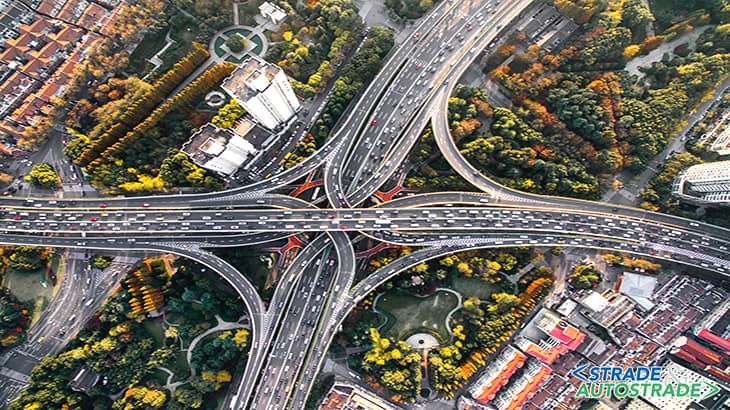Smart engineering and new technologies – part one ![]() Per la versione in Italiano: https://www.stradeeautostrade.it/its-smart-road/smart-engineering-e-nuove-tecnologie-prima-parte/
Per la versione in Italiano: https://www.stradeeautostrade.it/its-smart-road/smart-engineering-e-nuove-tecnologie-prima-parte/
This first part analyzes the status current road infrastructure, components internal and external and the factors that are conditioning future choices significantly.
The second part, on issue n. 138 November/December 2019 and https://www.stradeeautostrade.it/smart-road-digital-transformation/smart-engineering-and-new-technologies-second-part/, analyzes technical opportunities that the most up-to-date technological development is progressively presenting and that will radically transform the infrastructure road.
It will also address the necessary enabling factors to accelerate the adoption of new technologies, innovations emerging for the construction of the road infrastructure of the future.
Thanks to technological advances and smart engineering, new solutions that can make the streets more efficient are emerging. So far there has been a lot of focus on innovations concerning vehicle technologies. Wherever you look you can see it a new history of progress in the automotive field.
Self-driving and connected vehicles are now reality and have the potential to change industry and electrical rules are starting to enter common use. But all these technologies must necessarily work on a fundamental and universal platform: the roads.

If the innovation of road infrastructure does not keep up with the technological advances that affect vehicles, the high level traffic growth will remain a huge problem for all Countries and the true potential of these technologies cannot be realized in any way.
The remarkable speed of development of the automotive towards a vehicle increasingly autonomous imposes an urgent acceleration and the transformation of road infrastructure at all levels than in the rules; the transition from the level of self-connected (driverless car) at higher levels of autonomy of the vehicle (assisted driving, autonomous driving) requires mandatory a transformation of road infrastructure which, otherwise, they would not be able to accommodate.
We are facing a transformation of the country that requires, necessarily and with great urgency, that politics intervene taking not only measures but a real one long-term, coordinated, shared development plan, within which each of the Stakeholders must carry out a specific participatory role. But at present this it does not exist yet.
The experimental initiatives are numerous but do not fall within a single design, in a single country development strategy: the tendency is to act on one’s own account or almost.
For to be able to define a development strategy, a path, an identity national that still do not exist today, it is necessary an active contribution from all Stakeholders, a sharing that is struggling to arrive.
Ministries find it difficult to plan development by finding themselves often having to take almost unilateral decisions to fulfill the mandatory commitments resulting from Directives, European regulations.
There are also other factors to be addressed such as exponential growth in the act of mobility, a factor that goes against the trend with respect to the concepts of the new mobility; this also phenomenon requires adequate intervention through a strategy which must be taken at national level. They are these the fundamental assumptions to be addressed through strategies targeted that must invest the entire mobility system e of transport.
The increase in traffic and congestion
The World Economic Forum (WEF) estimates that the number of cars worldwide will grow by 600 million between 2014 and 2025, leading to increased congestion unless it infrastructure development does not keep pace with change.
Vehicles are responsible for 17% of global emissions of carbon dioxide CO2, as well as dioxide emissions NO2 nitrogen and fine particulates. In the EU alone this has caused more than 450,000 premature deaths, which cost the economies of regions affected over 1.4 trillion US dollars per year. Self these challenges will not be addressed, they will translate into heavy ones lasting economic burdens for countries around the world.
For road infrastructure, the opportunities to face the challenges posed by increasing traffic occur on two fronts. The first is that of intelligent infrastructures, which will facilitate the introduction and diffusion of self-driving vehicles will allow more traffic and infrastructure management proactive and will transform the way people think to mobility.
The second is that of surface technologies, where smart engineering is helping to transform the passive infrastructures in dynamic resources with developments and transformations infrastructure such as inductive charging and “solar roads”.
In Italy the Guidelines for Smart Roads are the prerequisite for an adequate and coordinated transformation of the country, but at the moment there is still a too slow progression.
Self-driving and connected vehicles require an urgent transformation of road infrastructure
At one time the roads were limited to physical elements such as barriers, traffic lights and signs: now road infrastructure includes digital components, such as wireless network technologies, artificial intelligence and augmented reality, which are the product of the “digital transformation”.
The emergence of self-driving and connected vehicles is driving this change, since they are based right on telecommunication infrastructure to communicate with other vehicles and other infrastructures.
It is time for the definition of road infrastructure to evolve to include not only physical elements, such as roads and bridges, but also digital and electronic components. Smart infrastructures offer many opportunities to improve efficiency and safety of the streets.
For example, smart infrastructure is a factor essential and enabling to allow the spread of vehicles autonomous driving, which promise to reduce accidents by 90% road. This is a substantial problem considering that the technological development of the car is already at the 3-4 SAE level.
The infrastructure system is very late compared to vehicles in terms of system strategy (system thinking)
The delay, in large part, depends on whether the vehicles are on center of interest of the private sector, while on infrastructure road the public sector is focused.
Bear in mind that the transition from connected driving to driving autonomous will be determined by the degree of evolution of the infrastructures roads that need to be wider, more smart.
The automated vehicle cannot operate unless there is a smart infrastructure. To be completely autonomous, a vehicle must be able to rely on a complex system and integrated which provides a series of surrounding elements: both static, such as roads and transmission towers, and dynamic, like other vehicles. This requires multiple technologies that despite progress has not yet reached what is necessary degree of maturity.
Self-driving vehicles employ many types of sensors, i.e. video cameras, ultrasonic detectors, radar and LIDAR (optical radars), to provide the necessary information for unmanned driving.
Their ability to interact with the road infrastructure e with other vehicles it can be improved with predisposition adequate infrastructure. The Internet of things is also the focus of this process, which requires a system of telecommunication infrastructures that guarantee wireless internet connectivity and access to the mobile network.

Smart Road: the transformation of the road from a passive element to a resource
Smart and automotive technological development in its various applications requires you to urgently address the adjustment road infrastructure that otherwise would not be able to accept it and contextually the issues that concern it the challenges of increasing traffic.
The streets occupy large areas surface, in the cities and throughout the territory of the various countries e so far they have played the role of essential but passive good; it we see are the many ways that infrastructure is becoming smarter, smarter, how data is used to radically transform traffic management and determine new forms of mobility, and like rapid changes in road surface technologies are changing the the way we think of the streets, not as a passive element but as a resource.
Indeed, current developments in the environmental and energy fields they are transforming the value of these assets by experiencing infrastructure that generate electricity, in an attempt to reduce energy infrastructure costs, free up resources for other uses, accelerate the rise of electric vehicles and reduce emissions.
In addition to improving road safety very significantly (depending on the studies carried out we move on to a possible one reduction ranging from 68% to 90%), self-driving vehicles will influence the future of engineering and road design.
For example, parking spaces may be reduced, because these vehicles need only about ten centimeters of lateral distance and not of the distance necessary to open a door, since the driver does not have to enter and exit.
Likewise the road capacity will also increase thanks in narrower lanes, in consideration of the fact that cars autonomous should exercise better control of lane compared to humans. Future scenarios include lanes of ring roads, overpasses and underpasses reserved for guided vehicles autonomous in order to improve traffic flows.
Essential assumptions
The new mobility depends even more on collaboration/partnership/sharing between Governments and all Stakeholders. It increasingly emerges that a boundary condition is implemented: the development of mobility in economic, environmental profiles, energy, technology that must be set both in fact dependent on collaboration/sharing/partnership between Governments, innovators, actuators, large and small. And here, for Italy, so far there is a lack of predisposition…
The need to identify new ways to finance infrastructure innovations
In view of the necessary continuous increase in requests of public funding, it is imperative to explore new ones ways to finance the necessary infrastructure innovations a support the adoption of these new technologies.
Infrastructure roads are the platform for the future of mobility Smart technologies are at the heart of creating multiple roads smart, clean and safe. Governments also need to pursue new approaches to finance technology upgrading roads that require significant resources.
Governments themselves also have the important thing task of financing and making possible pilot projects and experiments related to road technologies, as well as promoting new ones multidisciplinary skills required by the projects on smart road infrastructure. The next five to ten years will be crucial for determine the future of roads in the world.
Private companies have funds relatively important for research and development and are encouraged to act quickly when in advantages of grabbing a market result be substantial. What is more, these developments are taking place in a context of rapid progress technology in other modes of transport.
The public sector, on the other hand, must confront potential public opposition, with fragmented decision making processes e with high potential costs in the event of bankruptcy, given that infrastructure decisions it is difficult to go back.
The new approach of people towards different forms and ways of moving
The confluence of the trends in automotive technology, the big data and sharing economy is changing the approach of people with regard to travel. And this is one of conditioning factors with respect to the acceptability of these new ones move, get organized, which affects implementation times. Factor which requires important awareness raising interventions.
But, together with the rapid rate of population growth, these developments will help increase traffic already occurs at unsustainable levels. The increase in traffic is driving productivity losses, road accidents, pollution atmospheric and a negative impact on public health.

The crucial role of Governments
The crucial role of governments in planning interventions infrastructures and their financing to allow a greater diffusion of these technologies. It is necessary that the politics create the conditions for standards to develop common for smart road infrastructure, creating regulatory frameworks and good practices to share and protect the results achieved. Governments must also identify new ones approaches to finance the upgrading of road infrastructure that require significant resources.
The development of intelligent road infrastructure requires to have common standards, frameworks regulations and best practices, collaboration sharing among all Stakeholders to protect the results achieved.
Technical standards and frameworks regulations conceived today will shape the way where the roads will be built and managed in the years to come. The first experiences of drivers and other Stakeholders in the projects pilot and other initial implementations will influence both the behavior of the drivers and public opinion.
Political leaders who want to seize opportunities offered by technology in terms to improve safety and sustainability and the efficiency of the roads must intervene in the process as soon as possible.
However, services like these, based on data sharing, they need policy makers and supervisory authorities find the right balance between practicality in management as soon as possible the information system, cybersecurity and privacy.
Read part two of the article about smart engineering and new technologies on issue n. 138 November/December 2019 and on https://www.stradeeautostrade.it/smart-road-digital-transformation/smart-engineering-and-new-technologies-second-part/.
Smart engineering and new technologies – part one ![]() Per la versione in Italiano: https://www.stradeeautostrade.it/its-smart-road/smart-engineering-e-nuove-tecnologie-prima-parte/
Per la versione in Italiano: https://www.stradeeautostrade.it/its-smart-road/smart-engineering-e-nuove-tecnologie-prima-parte/
> Se questo articolo ti è piaciuto, iscriviti alla Newsletter mensile al link http://eepurl.com/dpKhwL <

